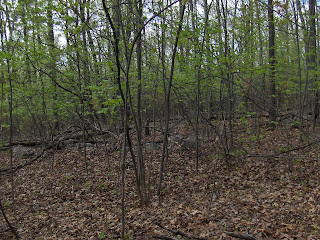But I was disappointed to not see any rectangular mounds with hollows. Since this is the headwater of some brook (I could not figure out which one, as it seems to have been buried underneath downtown Hudson). Anyway, in the end I was not disappointed: there was only one mound and it was made of soil, not rocks.
As fine an example as you could hope to see:
No that is not a house foundation - there is water at the bottom of the hole.
And nearby, at the edge of the water:
Again:
There was also another lobe of land just to the east that also looked out over the pond. It seemed too well visited to spend time examining but this did catch my eye:
Then I headed sharply uphill, skirting the end of a road and found marker piles all the way up the slope and some older looking "rectangles" on the flat summit/shoulder looking out to the south.
For example on the slope:
Further up (note some of the details here: the larger rock, the cashew shaped smaller rock, the swirl of schist):
We are still climbing the hill and the trail goes right through the rock piles. [How many hikers have ever noticed? Zero?]
This is much more than I expected to squeeze out of a small bit of the landscape - so near Hudson and at the edge of an area - around Marlboro and Southboro (and all those "boros") - that is a real dead zone for finding rock piles. Let me digress to say that this dead zone may be due to the fact that the towns around Marlboro are sandy. But I wonder about a cultural divide that separates Nashoba and Upper Middlesex (my version of Thoreau's Estabrook) from the towns around Holliston, Hopkinton, and Upton (we could call them the "tons") where the ceremonial stonework could be seen as different. I am not sure if it is different enough to support the idea of a cultural divide. I am not sure the Nashua and Merrimack watersheds are different from the watersheds that drain more to the south, nor if these differences are a projection; nor if those places have enough uniformity within themselves to be characterized this way. Yet I think there is a difference.
Ah! Here we are on the southern end of the summit:
These are exactly the sorts of things that I am not sure I see much of - further south in the "tons". But Scott Reservoir, Cowassock Woods, Briar Ridge Rd Acton, maybe Kezar Hill? And the stuff about "lazy 9".
Again
You can see why I think it counts as a "rectangle" and there is a hint of inner wall dividing it in two. There was at least one other similar thing up there, I did not get good pictures:
And a bit east around the side of the hilltop, some more marker pile-like items:
A lot more than I expected to find. Clearly those hills were crucial real estate for ceremony:



















3 comments :
Picture number 7 is really nice. The propped boulder displays a symbol I have seen before in many Propped Boulders and Standing stones, such as at Saddle Hill in Hopkinton, the woods of Milford, etc. There is a triangular notch chinked out on one of the sides of the base of the boulder, creating an empty space, or niche.
Further (I don't want to sound like a "know it all" because I am not), I would say that stone structures vary from structure to structure, even within the same townships. For example: the giant platform stone mound above the swamp at Miller Hill in Holliston is unlike anything else in that area. Stone mounds and cairns which carry a Turtle motif are to be found in many states. The propped boulder mentioned in the above picture #7 of this post (as of the writing of this comment); could just as well be located in Rhode Island or Connecticut. Of course, it is not. It is a special stone in it's own special place, but the way it is propped, to my eyes, when compared to some other propped boulders I have seen (see for example Larry Harrop's slideshow on YouTube on Rhode Island structures), would imply the significance of a homogenous cultural practice among the ancient Native American ceremonial stone landscape and the people who erected them.
Peter -
I agree with you about the "dead zone". It may be due to overdevelopment, at least of the urbanized areas of Marlboro and Hudson, but when it comes to Southborough, that doesn't fly. Not only are there very, very few stone structure sites in Southborough, there are also very few ordinary habitation sites their, either. Some of them may be located under the waters of the Sudbury Reservoir, but I wonder why no one has reported any sites on the islands or hills in that area. In my understanding of the distribution, there are distinct site clusters with rather clear boundaries. There is one cluster, which you and others have explored, in the area of the Callahan State park, extending into the area of Lee Swanson's sites in Sudbury, and it is separated from the much larger Metro-West cluster, of which the new sites are a part. And if you examine the orientation of the southern edge of the entire Metro-West cluster, it aligns nicely with summer solstice sunrise/winter solstice sunset. Could that be intentional?
I'd have to see a map of the "Metro-West cluster".
I want to say there are a few sites in there but it really is pretty empty. All the way west to Crane Swamp in Westboro and right on out the Mass Pike.
Post a Comment